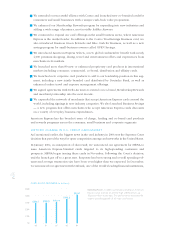American Express 2004 Annual Report Download - page 13
Download and view the complete annual report
Please find page 13 of the 2004 American Express annual report below. You can navigate through the pages in the report by either clicking on the pages listed below, or by using the keyword search tool below to find specific information within the annual report.
Our business-building activities over the past several quarters generated substantially
higher customer volumes in 2004, including: exceptional growth in cards-in-force and
spending per card, higher sales and asset levels at AEFA, and increased commissions, fees
and assets at American Express Bank (AEB).
The strength of our current business and future prospects led us to pursue the spin-off of
AEFA. The proposed spin-off will enable both American Express and AEFA to focus attention
and resources on maximizing our best growth opportunities.
American Express will be able to concentrate resources on our global payments and net-
work businesses, where we have the highest returns on investment and enormous potential
for growth given the excellent competitive position of our proprietary card business and
new opportunities created by our U.S. network business. The spin-off will strengthen our
ability to meet and exceed our long-term targets for earnings and revenue growth, and
enable us to increase our long-term return on equity target to 28 to 30 percent from the current
18 to 20 percent.
After the spin-off, American Express will be the world’s largest charge and credit card issuer
by spend volume and operate a network that processes more than $400 billion in transactions
from millions of merchants throughout the world. We will also continue to operate the lead-
ing global travel and Travelers Cheque businesses and an international bank serving affluent
consumers and financial institutions.
Our spend-centric business model and multiple product lines provide diverse sources of
revenue and differentiate us from competitors. We have a broad-based, global franchise
with leadership positions in the consumer, small business, middle market and large corpo-
rate card sectors. We have a diverse array of charge, lending, co-brand and prepaid payment
products. In addition, unlike many of our card competitors whose business models are focused
on lending, we generate revenues largely from activities associated with cardmember spend-
ing, as well as from lending, network services and other fees.
For AEFA, operating as an independent company would provide more flexibility and resources
to grow its asset management and insurance businesses, and its financial planning and advice
activities. AEFA would not have to compete for resources with other American Express busi-
nesses, and therefore would be able to react more quickly to market opportunities for new
products, partnerships and expansion.
We believe this is a winning scenario for American Express, AEFA and our shareholders.
AXP
AR.04
—
11
$2.07
$0.98
$2.01
$2.30
$2.68 Earnings Growth_ Our focus on growth, profitability and
stability resulted in higher earnings per share in 2004.
Diluted EPS rose to $2.68, a 17 percent increase over 2003
— ahead of our long-term target of 12 to 15 percent growth
on average and over time.
DILUTED EARNINGS PER COMMON SHARE
























